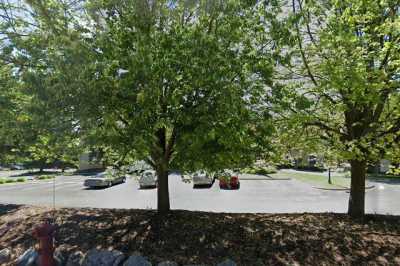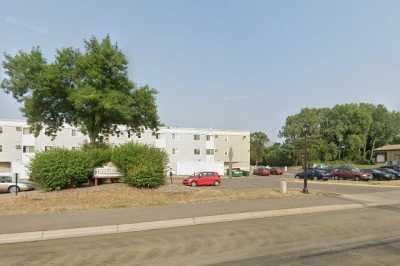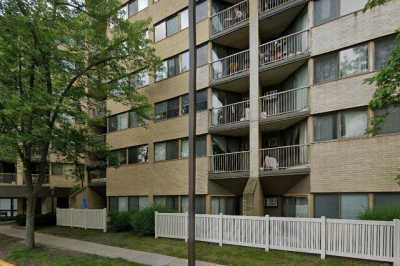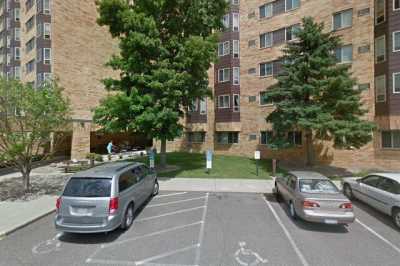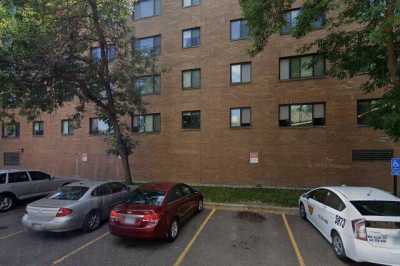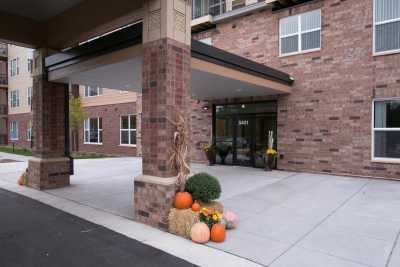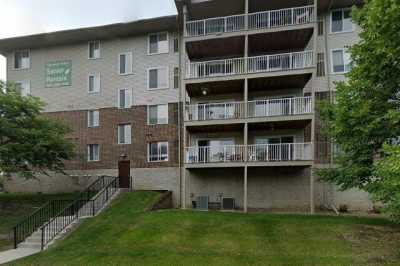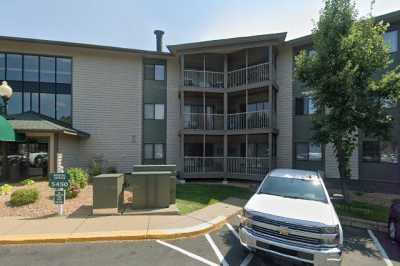
Senior Living Apartments in Minneapolis, MN
Minneapolis, renowned for its livability, vibrant arts scene, and proximity to nature, is a preferred choice for retirees. Together with St. Paul, it constitutes the Twin Cities, a metropolitan area that spans almost 3,000 square miles and serves as the home of nearly 3 million people. It’s home to several universities, museums, and sports teams, all with their own unique appeal. With landmarks such as Mall of America and the Minnesota Zoo close by, residents and visitors always have something to do.
Some active and independent retirees opt for the convenient living of senior apartments, which typically cater to seniors by providing accessibility features such as elevators and wide doorways. In general, senior apartments don’t provide health care services or daily assistance, though some of the 17 facilities within A Place for Mom’s Minneapolis network include aspects of independent living communities that offer added benefits.
In this guide, we’ll help you find the ideal Minneapolis senior apartment by breaking down the costs of senior apartments within a 10-mile radius of downtown, outlining the various ways to pay for living expenses, explaining applicable local and state regulations, and highlighting the unique characteristics of living in the City of Lakes.
Senior Apartments Facilities near Minneapolis, MN
Our free advisors can help
- Compare local facilities
- Determine care type
- Schedule tours
- Evaluate pricing
Our methodology
How we rank order the Minneapolis community options above
We developed a proprietary recommendation system that orders Minneapolis community options based on factors we know are important to seniors and their families:
- Proximity to your search location
- Availability of recent, high-quality reviews
- The amount of detailed community information available
Where we source our information
14,000+ communities
We collect proprietary data from our network of 14,000+ senior living communities in the U.S., with regular refreshes of data and information
350,000+ reviews
We have 387,000+ reviews from senior living residents and family members that provide first-hand accounts about senior living communities
- Costs of senior apartments in the Minneapolis area
- What families are saying about senior apartments in Minneapolis
- How people pay for senior apartments in Minneapolis
- Understand Minnesota laws and regulations for senior apartments communities
- What to expect from senior apartments in Minneapolis
- Explore senior care with confidence
- Unfamiliar with Minneapolis? Highlights for seniors
- Health care for seniors in Minneapolis
- Transportation for seniors in Minneapolis
- Senior activities in Minneapolis
Costs of senior apartments in the Minneapolis area
The cost of senior apartments in Minneapolis can be strongly influenced by location, size, and amenities. The 17 senior apartments in our network cost an average of $1,282 per month, which includes rent and any other fees or add-on services.[01]
The pricing listed below are the base rental rates for senior apartments in the area and do not include fees or additional services and amenities.
Average monthly cost of Senior Apartments in Minneapolis, MN vs. nearby cities
Average monthly cost of Senior Apartments in Minneapolis, MN vs. the state and national average
Average monthly cost of Senior Apartments in Minneapolis vs. other types of senior living
Median monthly costs of Senior Apartments in Minneapolis, MN by room type
What families are saying about senior apartments in Minneapolis
Recent reviews for senior apartments in Minneapolis
Falcon Heights Senior Living
Phalen Senior Lofts in Saint Paul, MN
Walker Methodist Hazel Ridge in Maplewood, MN
How people pay for senior apartments in Minneapolis
Senior apartments are classified as general housing rather than senior care communities because they don’t provide services like personal care. For this reason, long-term health care insurance doesn’t help pay for senior apartments in the same way that it does for other care communities.
Most Minneapolis senior apartments are paid for with personal funds, but various housing assistance programs, veterans programs, and disability benefits programs can help offset the costs of living for certain low-income seniors. If seniors should need medically essential in-home health care within their apartments, that care may be covered by Medicaid, Medicare, veterans benefits, public assistance, or other long-term care insurance programs covered below.
Seniors often rely on their personal savings and income resources — investments, savings accounts, Social Security benefits, and pensions — to pay rent on a senior apartment. Additional payment alternatives could include a combination of the private sources listed below.
Number of veterans who live in Minneapolis
About 44% of Minneapolis veterans are 65+
Minneapolis seniors have access to veterans programs, information centers, and veterans services officers that provide information and connect veterans to federal benefits. VA benefits and local assistance resources are available to help older veterans pay for living expenses. Veterans who receive VA Pensions can use them to pay for senior apartments in Minneapolis and can check eligibility guidelines here.
Some veterans may also be able to make use of the U.S. Department of Housing and Urban Development-VA Supportive Housing (HUD-VASH) program. If eligible, they will receive rental assistance from the Department of Veterans Affairs. Eligibility requirements can be found here.
Disabled veterans enrolled in VA health care can apply for the VA’s Aid and Attendance benefit, which provides seniors with additional support on top of their VA Pensions and can cover senior living expenses that improve the quality of life. To apply, seniors must fill out VA Form 21-2680 and either mail it to the VA’s St. Paul Regional Office or take it to their regional VA office.
For help with benefits applications, contact a veteran advisor or veterans services officer, and they can assist in securing the correct benefits. Additional benefits enrollment help can be found from local veterans services organizations such as the American Legion, Disabled American Veterans (DAV), and Minneapolis Veterans of Foreign Wars (VFW). To find local chapters of these organizations, consult the resources below.
Resources for Minneapolis veterans
VA Regional Benefit Satellite Office
Minneapolis VA Medical Center
1 Veterans Drive
Minneapolis, MN 55417
Phone: 800-827-1000
St. Paul Regional Benefits Office
1 Federal Drive
St. Paul, MN 55111
Phone: 800-827-1000
Hours: Monday through Friday, 8 a.m. – 4:30 p.m.
Hennepin County Veterans Service Officers
300 S. Sixth St.
Minneapolis, MN 55487
Phone: 612-348-3300
Hours: Monday through Friday, 8 a.m. – 4:30 p.m.
Minnesota Veterans of Foreign Wars
Phone: 651-291-1757
Fax: 651-291-2753
Disabled American Veterans Department of Minnesota
State Veterans Service Building, Floor 3
20 W. 12th St.
St. Paul, MN 55155
Phone: 651-291-1212; 888-317-2291
Hours: Monday through Friday, 7:30 a.m. – 3:30 p.m.
American Legion Minneapolis/Richfield Post 435
6501 Portland Ave.
Richfield, MN 55423
Phone: 612-866-3647
American Legion Minneapolis Post 99
5600 S. 34th Ave.
Minneapolis, MN 55417
Phone: 612-724-9909
Hours: Tuesdays, Wednesdays, Thursdays, 4 – 8 p.m.; Fridays, 4 – 9 p.m.
Giantvalley American Legion
3751 Minnehaha Ave.
Minneapolis, MN 55406
Phone: 612-729-6824
Hours: Monday through Sunday, 9 a.m. – 4 p.m.
American Legion Department of Minnesota
20 W. 12th St., Room 300-A
St. Paul, MN 55155
Phone: 651-291-1800; 866-259-9163
Fax: 651-291-1057
The Medicaid program in Minnesota, called Medical Assistance (MA), does not cover senior apartment rent, but it could help with health care costs. Learn more about what medical fees and services it can cover here. To apply for the MA program, use this application link.
Seniors who require assistance with activities of daily living in their homes can apply for one of Minnesota’s Home and Community-Based Services (HCBS) waivers to help cover costs. HCBS waivers cover a wide range of in-home person-centered care services. Further information about these Medicaid programs can be found in the resources section below.
If you need assistance navigating the various Medicaid options available to you, the Area Agency on Aging, known as Trellis, or the area ombudsman program can help. Contact information for these offices can be found in the Medicare resources listed below.
Minneapolis resident Medicaid resources
Minnesota Medicaid Ombudsman
Phone: 651-431-2660; 800-657-3729
Email: dhsombudsman.smhcp@state.mn.us
Trellis: Area Agency on Aging
1265 Grey Fox Road, Suite 2
Arden Hills, MN 55112
Phone: 651-641-8612
Hennepin County Health Care Assistance
Phone: 612-596-1300; 844-803-8466
Hours: Monday through Friday, 8 a.m. – 4:30 p.m.
MHCP Provider Resource Center
Phone: 651-431-2700; 800-366-5411
Medicare is a government health insurance program that covers medical expenses for those 65 and older and certain disabled individuals. Its coverage includes hospital stays, doctor visits, and medical equipment but not non-medical expenses, such as rent for senior apartments. It can help with short-term medically necessary in-home care.
Visit the official Medicare website to learn more details on what Medicare covers, or visit a local Social Security Administration office for more information or to apply for benefits. Minneapolis seniors who have qualified for the state’s Medical Assistance program may also be eligible for the Elderly Waiver program, which offers financial assistance for services (personal care assistance and skilled nursing care) that help seniors stay in their own homes. The program is administered by the Minnesota Department of Human Services.
Minnesota seniors can receive free health insurance advice from the State Health Insurance Help Program (SHIP) via Minnesota Senior LinkAge, run by the Minnesota Board on Aging. This service can help seniors understand coverage options, compare plans, and enroll in the appropriate plan. Additional state and local programs may be available based on income, assets, and other criteria. Contact the Senior LinkAge line or visit the Minnesota Board on Aging website for more information.
Residents can also save costs and apply for additional benefits such as:
- The Medicare Savings Plans (MSP), which assist in the payment of Medicare Part A and Part B costs. To find out if you qualify and apply for MSP, call the Senior LinkAge line at 800-333-2433 between 8:00 a.m. and 4:30 p.m., Monday through Friday.
- The Medicare Part D Low Income Subsidy (LIS), also known as Additional Help, helps to pay Medicare Part D monthly premiums, deductibles, copays, and coinsurance. Apply for the Social Security website or by calling the Senior LinkAge line at 800-333-2433 between 8:00 a.m. and 4:30 p.m., Monday through Friday.
- The Minnesota Board on Aging (MBA) supports Minnesotans of all ages and income levels in lowering prescription drug expenditures. The Senior LinkAge line helps callers locate manufacturers’ patient assistance programs and complete applications.
And with the help of the local long-term care ombudsman, you can get help learning your options or find assistance with a complaint investigation, advocacy, and education.
Minneapolis resident Medicare resources
Social Security Administration Office
1811 Chicago Ave., Suite 1
Minneapolis, MN 55404
Phone: 855-257-0982
Fax: 833-902-2688
Office of Ombudsman for Long-Term Care
540 Cedar St.
St. Paul, MN 55101
Phone: 800-657-3591
Senior LinkAge
540 Cedar St.
St. Paul, MN 55164
Phone: 800-333-2433
Hours: Monday through Friday, 8 a.m. – 4:30 p.m.
State Health Insurance Help Program (SHIP)
Phone: 800-333-2433
Email: info@shiphelp.org
Low-income seniors often rely on Social Security and housing assistance programs to pay rent. Seniors with qualifying incomes can apply for rent vouchers through the U.S. Department of Housing and Urban Development (HUD); however, seniors and their families need to check with the individual senior apartment complex to ask whether it accepts Housing Choice Vouchers. Locally, the Minneapolis Office of Public Housing acts as the hub of information on public housing, rental assistance, and housing issues.
In Minnesota, seniors can use their Social Security income to cover living expenses, including rent in any senior residence. Social Security benefits eligibility is based on employment history and current situation. Various programs are available, each with different eligibility requirements:
- Social Security in retirement (also known as Social Security Retirement Benefit/SSR) does not require disability; however, work credits are required.
- Social Security in Disability Insurance (or SSDI) requires both disability and work credits to qualify.
- Supplemental Security Income (or SSI) is available to people who are disabled and have no work credits.
- Social Security Survivors Pension is specifically for those with no work experience and requires no disability.
To get more details and application help, contact the local Social Security Administration (SSA) office for retirement, disability, and survivor benefits.
Locally, Minneapolis offers affordable housing and rental assistance programs for low-income individuals through organizations like the Minneapolis Public Housing Authority and the Community Action Partnership of Hennepin County. These programs and services include rental aid, energy assistance, and weatherization initiatives for low-income individuals and families.
Minneapolis has several organizations that offer advocacy and support services for seniors and people with disabilities who need help with securing the aid to which they’re entitled. The Minnesota Disability Law Center offers legal services and support with Social Security disability applications. The Trellis Area Agency on Aging, which operates Senior LinkAge line services in the Twin Cities, provides information, resources, and advocacy for seniors and caregivers.
Minneapolis resident public assistance resources
Minneapolis Office of Public Housing
212 Third Ave. S., Suite 150
Minneapolis, MN 55401
Phone: 612-370-3000
Hours: Monday through Friday, 8 a.m. – 4:30 p.m.
Minneapolis Public Housing Authority
1001 N. Washington Ave.
Minneapolis, MN 55401
Phone: 612-342-1400
Hours: Monday through Friday, 8 a.m. – 4:30 p.m.
Community Action Partnership of Hennepin County
8800 MN-7 #401
St. Louis Park, MN 55426
Phone: 952-933-9639
Hours: Monday through Friday, 8 a.m. – 4 p.m.
Social Security Administration (SSA)
1811 Chicago Ave., Suite 1
Minneapolis, MN 55404
Phone: 800-772-1213
Hours: Monday through Friday, 9 a.m. – 4 p.m.
Disability Law Center of Minnesota
111 N. Fifth St., Suite 100
Minneapolis, MN 55403
Phone: 612-332-1441
Hours: Monday through Thursday, 8:30 a.m. – 4:30 p.m.; Friday, 8:30 a.m. – noon
Trellis Area Agency on Aging
1265 Grey Fox Road
Arden Hills, MN 55112
Phone: 651-641-8612
Hours: Monday through Friday, 8 a.m. – 4:30 p.m.
Understand Minnesota laws and regulations for senior apartments communities
Senior apartments in Minnesota must comply with federal, state, county, and city housing rules. These apartments are mainly for people aged 55 and over, with additional requirements such as income limits or background checks in some cases.
In Minnesota, senior living facilities must comply with the federal Fair Housing Act and Americans with Disabilities Act (ADA) to ensure access to housing for seniors with disabilities. Public areas (such as lobbies and corridors) must be accessible to disabled individuals, and new buildings or renovations must meet ADA accessibility standards. Additionally, the Minnesota Human Rights Act ensures that seniors with service or emotional support animals are not discriminated against, even at facilities with a no-pet policy. That said, therapy animals are not legally protected and may be prohibited.
Minnesota housing laws for senior apartments require compliance with tenant rights and responsibilities, including Housing and Urban Development’s requirements (HUD) requirements for Section 8 vouchers. Senior housing must follow maintenance and safety laws, such as installing smoke and carbon monoxide detectors and fire extinguishers. The landlord is responsible for the property’s upkeep and safety.
Because every landlord must also possess a rental license, their rental properties are subject to regular inspections by the city’s Inspection Services Division to ensure that health, safety, and livability standards are being met. This checklist provides an overview of what inspectors look for. Information about every active rental license can be found here, and property-specific Regulatory Services violations can be found here. Residents can access the Housing Maintenance Code of Minneapolis guide for detailed information on building codes.
Minnesota Department of Health contact information
Minnesota Department of Health
625 Robert St. N
St Paul, MN 55164
Phone: 651-201-5000
Hours: Monday through Friday, 8 a.m. – 4:30 p.m.
COVID-19 regulations for Minneapolis senior apartments communities
Minneapolis has no specific COVID-19 requirements in place for senior apartments, but local health officials provide general information on testing locations, resources, and closures. Those over age 65 can receive a booster shot six months after receiving a Pfizer or Moderna vaccine and can choose to take either vaccine. The Centers for Disease Control and Prevention now allows mixing and matching for booster shots.[02]

Vaccinations.
Staff and visitors should stay up-to-date with COVID-19 vaccines, including recommended booster doses.

Masking.
Masks are not required right now in Minneapolis.

Facility cleanliness.
Management should maintain the necessary ventilation improvements in their facilities in order to prevent the spread of COVID-19.

Staff safety.
Employees should wash their hands frequently with soap and water or use a hand sanitizer with at least 60% alcohol.
What to expect from senior apartments in Minneapolis
Senior apartment communities in Minnesota offer low-maintenance living for active persons over 55, with amenities like golf, swimming pools, and fitness centers. This allows seniors to stay active throughout the year, from the state’s warm summers to its famously snowy winters. Community fees cover basic services (like electricity, landscaping, house upkeep, and security), but not health care or everyday support. Because they cater to seniors, the apartment units are often designed with accessibility features like elevators and wide doorways.
Some communities even offer restaurant-style dining and food prepared by professional chefs. It might be possible, for example, to eat in a private dining room and go to an on-site café for dessert. When this is added to other commonly provided amenities, the senior apartment experience has the potential to be downright luxurious.
Within a 10-mile radius of downtown Minneapolis, there are 17 senior apartment facilities we partner with: 13 standalone senior apartment facilities and four that are combined with independent living. Broadened to a 25-mile radius, there are nine additional standalone senior housing facilities, with one being a combination of senior apartments and independent living.[01]
Senior apartments are made accessible for seniors with disabilities.
Minneapolis senior apartments are adapted to minimize the daily hassles for seniors, so they frequently include amenities such as ground floor units, ramps, and accessible showers. Maintenance, housekeeping, and other convenient services or features can be included in leasing fees as well.
Apartments are accessed easily by multiple modes of transportation.
The big benefit of living in a senior apartment in Minneapolis is that residents can easily use public transportation to get around; 80% of our partner senior apartment complexes are conveniently located close to public transit.[01] Minneapolis’ network of buses can bring seniors virtually anywhere in the Twin Cities, and the light rail can take them directly to Target Field for a ball game or Mall of America for a day of shopping.
For those who own their vehicles, there’s resident parking available at 88% of our partner senior apartments. Moreover, seniors can use complimentary transportation as a service to visit their doctor or run errands.
Apartments are designed practically to accommodate seniors.
With ground floor units and wheelchair access available, seniors can live on almost any floor. The apartment units usually (82% of complexes among our listings) include full kitchens with appliances. There are washers and dryers installed, but some apartments also offer laundry services. Senior apartments frequently include their own patios or balconies, which can have spectacular views of the city skyline. Some residences even include an in-unit emergency response system or night patrol to make residents feel safe.
Explore senior care with confidence
Know where to start.
Identify the right care for your loved one with our free assessment.

See what you can afford.
Understand cost and payment for long-term care based on your loved one's needs.

Find top facilities for you.
Free, personalized guidance from our Senior Living Advisors can help you narrow your search.

Tour your favorite facilities.
Our free touring checklist can help you choose the right community.
Unfamiliar with Minneapolis? Highlights for seniors
Number of seniors over the age of 65 currently living in Minneapolis
Median annual income for Minneapolis seniors 65 and older
Health care for seniors in Minneapolis
With a nationally ranked hospital in the city, Minneapolis has an abundance of health care options for seniors. The city is home to multiple well-renowned hospitals as well as a VA center for veterans. Check out the information below to learn more about Minneapolis’ top hospitals.

U.S. News & World Report has rated Abbott Northwestern Hospital as high performing in cardiology and heart surgery, as well as geriatric care and several other specialties.

Park Nicollet Methodist Hospital
Regionally ranked as the fourth best hospital in Minnesota by U.S. News & World Report, Park Nicollet Methodist Hospital is rated as high performing in numerous procedures including colon and prostate cancer surgery.

M Health Fairview University of Minnesota Medical Center
U.S. News & World Report ranks M Health Fairview University of Minnesota Medical Center in the nation’s top 50 for cancer care.

Primary care and specialized health services, such as surgery, psychiatry, neurology, oncology, and more, are provided by the main campus of Veterans Affairs.
Transportation for seniors in Minneapolis
Minneapolis is considered a highly walkable and bikeable city. This is confirmed by Walk Score, which puts Minneapolis’ walkability at 71 out of 100 and its bikeability at 83 out of 100. Walk Score takes into account public density, walking routes, biking routes, and public transit. Half of Minneapolis residents usually travel by car, yet 36% would prefer to bike, and 22% would rather use public transportation.
Minneapolis has 34 miles of dedicated bike lanes, with abundant biking, running, and walking trails along the area’s numerous lakes and Mississippi River banks. The city’s Nice Ride cycling program has more than 100 bicycle-sharing kiosks. Minneapolis METRO transit offers bus, light rail, and commuter train systems connecting Minneapolis riders to downtown Saint Paul and the airport.
Seniors aged 65 and older can get a reduced fare on buses and trains through the Metro Transit Discounted Rate for Seniors, and it offers 14 popular routes at such a high frequency of service (every 15 minutes or sooner) that riders can hop on without consulting a schedule. Additionally, the Northeast Seniors Rides program provides volunteer drivers to shuttle seniors aged 60 and over to appointments in Northeast Minneapolis, Columbia Heights, Saint Anthony Village, or New Brighton.

Walk Score

Transit Score

Bike Score
Senior activities in Minneapolis
With spectacular skylines and historic institutes, Minneapolis is a great place for seniors who want to experience both indoor and outdoor excursions.
Minneapolis offers plenty of free or low-cost activities, including walking, biking, and attending free performances at Lake Harriet’s Bandshell Park. The Minneapolis Institute of Art offers free tours, classes, and events for those interested in the arts. The Minneapolis Sculpture Garden, home of the iconic Spoonbridge and Cherry sculpture, is also free and open every day.
Another Minneapolis gem is the Walker Art Center, which provides an immersive experience starting with its contemporary art installations to community building projects. The center hosts various performing arts shows, including contemporary dance, experimental theater, and new jazz/classical music. Admission for seniors aged 62 and above is $13. Mill City Museum is also a must-visit to learn about the city’s birthplace with activities for all ages. Veterans and those above 65 get in for a reduced fee of $10.
Seniors who’re avid fans of classical music can also visit the Minnesota Orchestra, a Grammy Award-winning orchestra known for acclaimed performances around the world. The orchestra hall offers disabled parking spaces and convenient dropoff and pickup locations; inside, it offers armless and bariatric chairs, assistive listening devices, open captioning, and wheelchair and accessible seating.
Also wheelchair-accessible is the historic First Avenue, which hosts rock concerts and more. Seniors and their families can visit U.S. Bank Stadium to watch their favorite musical artists or even football games. The stadium also follows ADA guidelines and offers ramps, elevators, and wheelchair-accessible seating on all levels.
Sports fans will also appreciate that Minneapolis is one of just 12 cities to have teams in the NFL, MLB, NBA, and NHL: the Minnesota Vikings, Minnesota Twins, Minnesota Timberwolves, and Minnesota Wild, respectively. Minneapolis is also home to the Golden Gophers, the collective name for the University of Minnesota’s many sports teams.
Plenty of senior and community centers keep Minneapolis seniors busy. For seniors aged 50 and above, the Skyway Senior Center in downtown Minneapolis provides a safe and comfortable environment with activities and resources such as physical fitness, health and well-being, learning opportunities, and socialization events to avoid isolation.
Similarly, the Shorewood Community & Event Center offers quilting, beading, knitting, support groups, and other daily activities found in the Shorewood Senior Partners newsletter or on its website. Interested individuals can contact the Shorewood Center at 952-474-7635 to obtain a copy of their newsletter. Additionally, the Nokomis Healthy Seniors Center provides affordable health and wellness activities, social events, transportation, support groups, and exercise classes for seniors looking to socialize with others. For more senior-specific resources, check out the Minnesota Association for Senior Services’ list of the dozens of senior centers and organizations in the area.
Frequently Asked Questions
The Lodge at Little Canada, Legends of Apple Valley and OMRY Apartments are the top-rated Senior Apartments facilities near Minneapolis, MN. These Senior Apartments facilities received the highest rankings based on verified family reviews. See full list of communities.
The average cost of Senior Apartments in Minneapolis is $1,340 per month. This cost may vary based on location, amenities, floorplan, level of care and other factors.
References
A Place for Mom. (2023). A Place for Mom proprietary data.
Minneapolis, C. O. (n.d.). COVID-19 vaccines.
U.S. News & World Report. (2023). Abbott Northwestern Hospital in Minneapolis, MN – Rankings, Ratings & Photos
U.S. News & World Report. (2023). Park Nicollet Methodist Hospital in Saint Louis Park, MN – Rankings, Ratings & Photos
U.S. News & World Report. (2023). M Health Fairview University of Minnesota Medical Center in Minneapolis, MN – Rankings, Ratings & Photos | US News Best Hospitals Rankings
Veterans Affairs. (2023). VA Minneapolis health care.

More questions?
Ask an A Place for Mom local advisor at no cost.
- Richfield, Minnesota
- Osseo, Minnesota
- White Bear Lake, Minnesota
- New Brighton, Minnesota
- Maplewood, Minnesota
- Shakopee, Minnesota
- Lakeville, Minnesota
- Ham Lake, Minnesota
- Wayzata, Minnesota
- Blaine, Minnesota
- Mound, Minnesota
- Lilydale, Minnesota
- West St. Paul, Minnesota
- Hopkins, Minnesota
- Bloomington, Minnesota
- Hugo, Minnesota
- Plymouth, Minnesota
- Ramsey, Minnesota
- Savage, Minnesota
- Prior Lake, Minnesota


